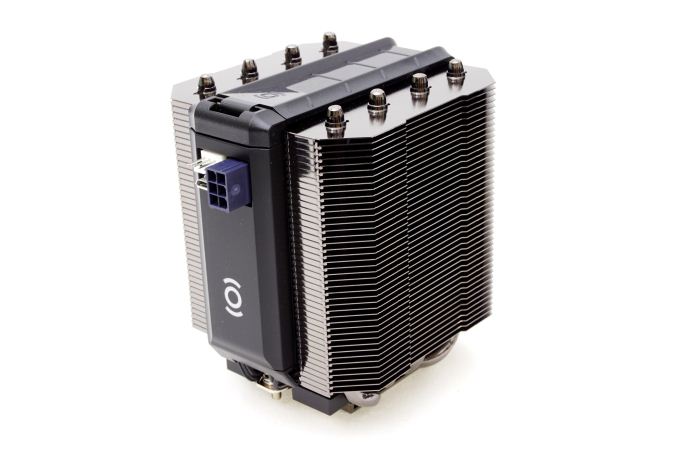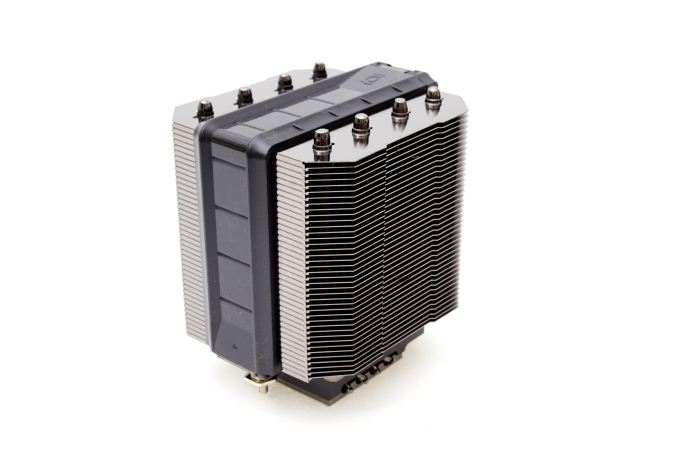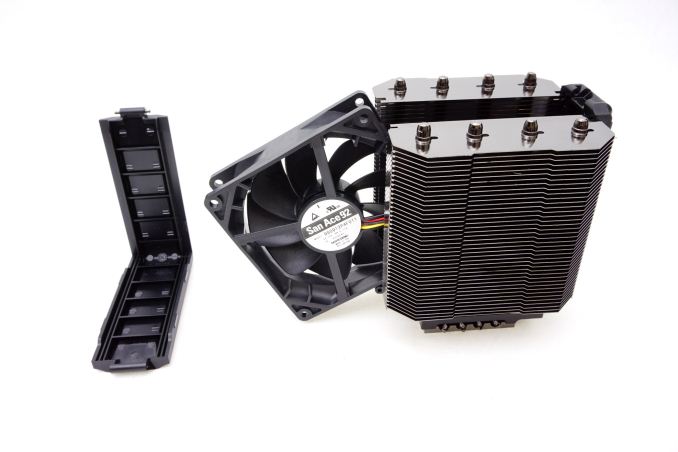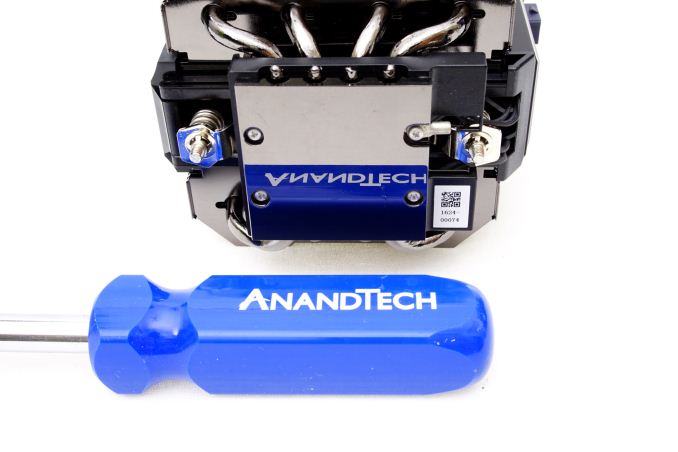The Phononic HEX 2.0 TEC CPU Cooler Review
by E. Fylladitakis on September 26, 2016 9:30 AM EST- Posted in
- Cases/Cooling/PSUs
- Cooler
- TEC
- Phononic
- HEX 2.0
The Phononic HEX 2.0 Thermoelectric Cooler
If not for the 6-pin PCI Express power connector at its side, the HEX 2.0 could be easily mistaken for a simple medium-sized tower cooler. It is only 12.5 cm tall and should fit in many narrow cases, where several top-tier air coolers cannot. The HEX 2.0 is a dual-tower design, with four heatpipes transferring the thermal energy from the CPU to two arrays of aluminum fins, and with the fan placed between the two fin arrays. In this case, Phononic also placed the control electronics in between the arrays and covered everything with a neat plastic frame.
Phononic put a significant amount of effort in the aesthetic design of the Hex 2.0. Both the aluminum fins and the copper heatpipes of the cooler are chromed. The tips of the heatpipes extruding above the fin arrays are perfectly symmetrical. Phononic also placed a very strong RGB LED inside the company logo beneath the connectors, the color of which is selectable via the control software (green by default).
The frame can be partially removed, revealing the 92 mm cooling fan and providing access to the mounting screws. It will have to come off in order to install the cooler, but it is not necessary to completely remove the fan as well.Note that the fan can be replaced but needs to be inserted in a specific direction, as marked on the base of the cooler. Phononic is using a very high quality Sanyo Denki San Ace 9S0912P4F011 fan. Even though it is part of Sanyo’s “Silent” range, this fan has a maximum speed of 2650 RPM and will be quite loud should it operate at maximum speed.
The base of the cooler consists of a chromed copper plate that comes in contact with the CPU and a black aluminum frame that provides mechanical cohesion. Its chromed copper base is virtually a nearly perfect mirror. The TEC and the heatpipes are sandwiches between the copper plate and the aluminum frame. A temperature sensor can also be seen attached to one of the screws holding the base together.
The Software
The HEX 2.0 Dashboard software is very straightforward and lightweight. Not even an installation is required, the software is a simple executable file that can be launched instantly once downloaded.
To the left of the screen, the user can check the “cooling power”, which indicates the power of the TEC. There are three cooling profiles to choose from: standard, insane and high ambient. The standard mode addresses most users, where the firmware of the cooler will be adjusting the power of the TEC according to the thermal load. Setting the cooler to insane mode will lock the TEC at maximum power and, as the warning message says, it can cause condensation under certain conditions. High ambient mode sets the TEC to activate at higher thermal loads only to prevent condensation in very humid environments.
















48 Comments
View All Comments
MrSpadge - Tuesday, September 27, 2016 - link
Cooling at low power consumption levels (up to ~30 W) is very easy with modern coolers, unless you are restricting the hot air exchange with the environment (those HTPCs which for some reason have to be super small). If you're interested in such cases it would make more sense to test the case & envirnonment rather than the cooler itself.60 - 100 - 150 W covers typical CPUs under load very well, with 200 - 250 W representing overclocked socket 2011 chips and 340 W the extreme.
BurntMyBacon - Monday, September 26, 2016 - link
It would be interesting to see the crossover point between half on and full on. The aircooler isn't particularly large and doesn't seem to dissipate heat fast enough to keep up with the TEC. While providing a larger delta between the hot and cold plates, adding an extra 20W for the air cooler to deal with can, in some circumstances, actually increase the steady state temperature.A good test (that I'm not sure this kit would let you run) would be if you could test several TDP points at both half (20W) and full (40W) TEC power. I imagine you would see full power come in cooler up to the point that the air cooler starts failing to keep up. Switching to half TEC power would then be more efficient as it would dip back under that threshold. Once you increase thermal output to reach that threshold again, it would be interesting to see which mode works better with an overburdened air cooler. In the past, I've was told to use TECs with water cooling systems as air coolers at the time always got overburdened too early.
Avenger762 - Monday, September 26, 2016 - link
Once again, this thing is no match for my old CM V10. BTW the V10 in my tower has been running since 2006 with the exception of a couple of motherboard and fan replacements.VeauX - Monday, September 26, 2016 - link
it would be nice to see it compared to :1 - same size air cooler (comparable cu.cm or length / height / width)
2 - same price coolers including AIO Liquid Coolers
HomeworldFound - Monday, September 26, 2016 - link
I used to own a Thermaltake Subzero 4g Thermoelectric Cooler, used on a Pentium 4. This does seem like an evolved version of that. The Thermaltake used up a PCI slot and was oversized by 3/4 of an inch. There wasn't any condensation to deal with but I can't really say that it worked well.andychow - Monday, September 26, 2016 - link
Ask any physicist, and they will explain to you why thermoelectric cooling is a terrible idea. It's only if you need a specific solution, such as bellow ambient. Otherwise, it's super inefficient.powerarmour - Monday, September 26, 2016 - link
Yo dawg, I heard you need a cooler to cool your cooler?RaistlinZ - Monday, September 26, 2016 - link
I was interested in this until I saw the performance.Then I saw the price, and became even less interested.
benzosaurus - Monday, September 26, 2016 - link
In which we learn that "refrigeration" and "heat dissipation" are distinct and incompatible concepts.jlk440 - Monday, September 26, 2016 - link
Thanks for an interesting review. I'm puzzled by your reversal of the meaning of thermal resistance. Lower number = lower resistance = fewer degrees difference per watt of heat. For heatsinks, you want thermal resistance to be LOW, which means heat conductivity is HIGH. For some reason your terminology incorrectly calls lower resistance numbers "higher resistance", so maybe you mean higher conductivity (the opposite of resistance).